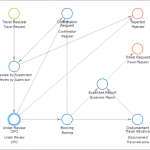4 Workforce Related Processes That Can Be Automated In Any Business
October 15, 2024
With new technologies steadily emerging, the way workforce processes are managed by businesses has evolved. Technology adoption in business processes has often been motivated by an aim to increase efficiency and productivity while reducing operating costs. When done right, this can simplify and optimize the workflows of almost any business.
Known as Business Process Automation (BPA), BPA is the use of software or a computer to automate the execution of tasks. It is an umbrella term that encompasses both human-driven automation and robotic process automation (RPA). BPA systems often automate time-consuming, repetitive, and manual tasks in order to make them more efficient.
For example, Chargebee’s subscription management software automates the recurring billing process, freeing up valuable resources and reducing manual efforts for businesses.
In this article, we take a look at 4 workforce-related business processes that can be automated in almost all sectors.
Table of Contents
4 Business Processes That Can Easily Be Automated
Team Communication and Management
Keeping team members, customers, and business partners up to date on important information is essential for any organization. With the number of stakeholders involved, it is easy for information to get lost or to forget passing the right information over to the right person. In its simplest form, automating your teams’ communication can be as easy as setting up repeat meeting reminders or staff alerts.
Furthermore, if your business deals with digital files or document transfers, most aspects can be pre-programmed, such as permission levels. Yet, many businesses still rely on traditional pen and paper or excel sheets, especially for roster management. By default, managing employee schedules is a tedious and resource-draining task for your human resource department. If you are looking into optimizing and streamlining this process, you should try employee scheduling tools which will tremendously reduce the workload while boosting your efficiency.
Key takeaway: 97 percent of employees feel that a project or task’s outcome is greatly impacted by a lack of alignment. Automation can improve collaboration and enhance team synergy.Recruitment and Employee Performance
Workforce recruitment is a multi-stage process that requires a lot of time and labor to be effectively performed. A report by Capterra reveals that 75 percent of recruiters make use of a recruiting or applicant tracking software (ATS). The same report highlights that 94 percent of ATS users report an improvement in their hiring process.
Along the same line, another area that is known to drain resources in monitoring employee performance. Evaluating how your staff performs over time is not only time-intensive but may also be met with biased opinions. This in turn may lead to poor employee engagement, which directly impacts your business productivity. Instead, relying on automated solutions to manage new recruit and employee data helps you save on resources and safeguards against potential bias.
Implementing automated solutions for tracking employee hours not only streamlines the evaluation process but also eliminates potential biases that may impact employee engagement and overall productivity. By relying on objective data collected through tracking employee hours, organizations can make informed decisions and ensure fair treatment of employees. This approach saves valuable resources, promotes transparency, and contributes to a more productive and equitable work environment.
Key takeaway: Automating employee data management makes decision making easier and brings more insights on hard-to-calculate figures, such as staff turnover cost.
Employee Payroll and Benefits Management
Regardless of the size of your business, managing employee payroll and benefits is a time-consuming process for any HR department. This is mainly because payroll and benefits management often involves multiple manual steps, such as salary calculation or clock-in monitoring. According to the PayStream Advisors’ 2018 Payables Insight Report, around 55 percent of organizations still process their accounts payable (AP) manually.
Similarly, managing staff benefits can be very resource-intensive, especially if you have hundreds of employees. Laws and policies vary drastically depending on the geographical location of your business, and maintaining compliance can be tough. Automating benefits management makes billing, tracking, and reconciliation easier and saves your business valuable resources, and leads to more accurate accounting.
Key takeaway: Automating employee payroll and benefits management ensures fewer human errors and mitigates compliance risks.
Claims Processing
Claims processing is another very time-consuming and expensive exercise for businesses that handle it completely manually. This process is often an arduous one for the claimant, the HR department, and the insurance company. Moreover, the process often leads to frustration for the different parties involved, since these claims are traditionally processed one at a time.
For these reasons, many organizations are turning to robotic process automation (RPA), a technology that enables them to automate their claims processing by connecting computers to systems such as e-signatures, spreadsheets, and document management systems. Turning to RPA speeds up claims processing and requires minimal human intervention. A study by McKinsey reports that businesses opting for RPA systems can see up to 200 percent return on investment (ROI) within the first year of implementation.
Key takeaway: Using an RPA for claims processing takes the pressure off the claimant and enables organizations to handle multiple claims and transactions at the same time.
Off you go
Business process automation appears to be an essential component of long-term sustainability. With 78 percent of business leaders stating that automation can increase productivity, we may soon see mass adoption of BPA technology. Whichever industry you are in, automation can increase efficiency and help save resources. Moreover, automating your business processes can give you an edge on the competition through greater savings on labor costs, increased customer satisfaction, and employee engagement.

